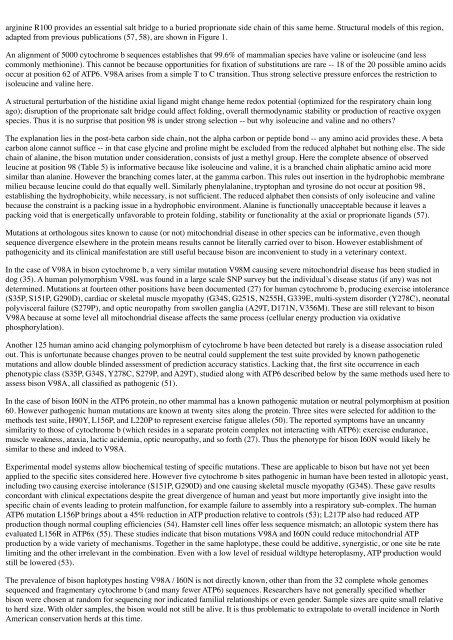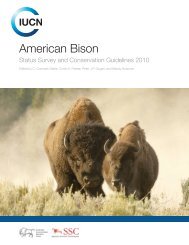Declaration Dr. Thomas H. Pringle - Buffalo Field Campaign
Declaration Dr. Thomas H. Pringle - Buffalo Field Campaign
Declaration Dr. Thomas H. Pringle - Buffalo Field Campaign
Create successful ePaper yourself
Turn your PDF publications into a flip-book with our unique Google optimized e-Paper software.
arginine R100 provides an essential salt bridge to a buried proprionate side chain of this same heme. Structural models of this region,<br />
adapted from previous publications (57, 58), are shown in Figure 1.<br />
An alignment of 5000 cytochrome b sequences establishes that 99.6% of mammalian species have valine or isoleucine (and less<br />
commonly methionine). This cannot be because opportunities for fixation of substitutions are rare -- 18 of the 20 possible amino acids<br />
occur at position 62 of ATP6. V98A arises from a simple T to C transition. Thus strong selective pressure enforces the restriction to<br />
isoleucine and valine here.<br />
A structural perturbation of the histidine axial ligand might change heme redox potential (optimized for the respiratory chain long<br />
ago); disruption of the proprionate salt bridge could affect folding, overall thermodynamic stability or production of reactive oxygen<br />
species. Thus it is no surprise that position 98 is under strong selection -- but why isoleucine and valine and no others?<br />
The explanation lies in the post-beta carbon side chain, not the alpha carbon or peptide bond -- any amino acid provides these. A beta<br />
carbon alone cannot suffice -- in that case glycine and proline might be excluded from the reduced alphabet but nothing else. The side<br />
chain of alanine, the bison mutation under consideration, consists of just a methyl group. Here the complete absence of observed<br />
leucine at position 98 (Table 5) is informative because like isoleucine and valine, it is a branched chain aliphatic amino acid more<br />
similar than alanine. However the branching comes later, at the gamma carbon. This rules out insertion in the hydrophobic membrane<br />
milieu because leucine could do that equally well. Similarly phenylalanine, tryptophan and tyrosine do not occur at position 98,<br />
establishing the hydrophobicity, while necessary, is not sufficient. The reduced alphabet then consists of only isoleucine and valine<br />
because the constraint is a packing issue in a hydrophobic environment. Alanine is functionally unacceptable because it leaves a<br />
packing void that is energetically unfavorable to protein folding, stability or functionality at the axial or proprionate ligands (57).<br />
Mutations at orthologous sites known to cause (or not) mitochondrial disease in other species can be informative, even though<br />
sequence divergence elsewhere in the protein means results cannot be literally carried over to bison. However establishment of<br />
pathogenicity and its clinical manifestation are still useful because bison are inconvenient to study in a veterinary context.<br />
In the case of V98A in bison cytochrome b, a very similar mutation V98M causing severe mitochondrial disease has been studied in<br />
dog (35). A human polymorphism V98L was found in a large scale SNP survey but the individual’s disease status (if any) was not<br />
determined. Mutations at fourteen other positions have been documented (27) for human cytochrome b, producing exercise intolerance<br />
(S35P, S151P, G290D), cardiac or skeletal muscle myopathy (G34S, G251S, N255H, G339E, multi-system disorder (Y278C), neonatal<br />
polyvisceral failure (S279P), and optic neuropathy from swollen ganglia (A29T, D171N, V356M). These are still relevant to bison<br />
V98A because at some level all mitochondrial disease affects the same process (cellular energy production via oxidative<br />
phosphorylation).<br />
Another 125 human amino acid changing polymorphism of cytochrome b have been detected but rarely is a disease association ruled<br />
out. This is unfortunate because changes proven to be neutral could supplement the test suite provided by known pathogenetic<br />
mutations and allow double blinded assessment of prediction accuracy statistics. Lacking that, the first site occurrence in each<br />
phenotypic class (S35P, G34S, Y278C, S279P, and A29T), studied along with ATP6 described below by the same methods used here to<br />
assess bison V98A, all classified as pathogenic (51).<br />
In the case of bison I60N in the ATP6 protein, no other mammal has a known pathogenic mutation or neutral polymorphism at position<br />
60. However pathogenic human mutations are known at twenty sites along the protein. Three sites were selected for addition to the<br />
methods test suite, H90Y, L156P, and L220P to represent exercise fatigue alleles (50). The reported symptoms have an uncanny<br />
similarity to those of cytochrome b (which resides in a separate protein complex not interacting with ATP6): exercise endurance,<br />
muscle weakness, ataxia, lactic acidemia, optic neuropathy, and so forth (27). Thus the phenotype for bison I60N would likely be<br />
similar to these and indeed to V98A.<br />
Experimental model systems allow biochemical testing of specific mutations. These are applicable to bison but have not yet been<br />
applied to the specific sites considered here. However five cytochrome b sites pathogenic in human have been tested in allotopic yeast,<br />
including two causing exercise intolerance (S151P, G290D) and one causing skeletal muscle myopathy (G34S). These gave results<br />
concordant with clinical expectations despite the great divergence of human and yeast but more importantly give insight into the<br />
specific chain of events leading to protein malfunction, for example failure to assembly into a respiratory sub-complex. The human<br />
ATP6 mutation L156P brings about a 45% reduction in ATP production relative to controls (53); L217P also had reduced ATP<br />
production though normal coupling efficiencies (54). Hamster cell lines offer less sequence mismatch; an allotopic system there has<br />
evaluated L156R in ATP6x (55). These studies indicate that bison mutations V98A and I60N could reduce mitochondrial ATP<br />
production by a wide variety of mechanisms. Together in the same haplotype, these could be additive, synergistic, or one site be rate<br />
limiting and the other irrelevant in the combination. Even with a low level of residual wildtype heteroplasmy, ATP production would<br />
still be lowered (53).<br />
The prevalence of bison haplotypes hosting V98A / I60N is not directly known, other than from the 32 complete whole genomes<br />
sequenced and fragmentary cytochrome b (and many fewer ATP6) sequences. Researchers have not generally specified whether<br />
bison were chosen at random for sequencing nor indicated familial relationships or even gender. Sample sizes are quite small relative<br />
to herd size. With older samples, the bison would not still be alive. It is thus problematic to extrapolate to overall incidence in North<br />
American conservation herds at this time.










